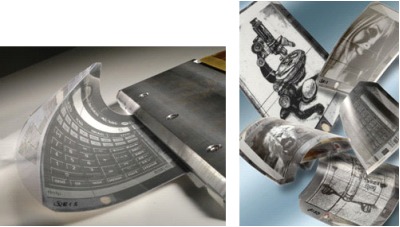Jan 27 2004
Based on research into polymer electronics, Philips is capable of producing prototypes of ultra-thin, large-area, rollable displays on a routine basis and intends to rapidly move towards an industrially feasible production process.
The displays combine active-matrix polymer driving electronics with a reflective 'electronic ink' front plane on an extremely thin sheet of plastic.
Lightweight, large-area displays that are unbreakable and can be rolled up into a small-sized housing when not actively used, are particularly attractive for mobile applications.
Ultimately, large-area displays could become feasible, which are so flexible that they can be integrated into everyday objects like a pen.
The availability of such displays would greatly stimulate the advance of electronic books, newspapers and magazines, and also new services offered by (third generation) mobile network operators.
These applications currently depend on fragile, heavy and bulky laptops or small, low-resolution displays of mobile phones, which both have clear drawbacks.
Philips not only wants to prove the feasibility of such displays, but also has the ambition to rapidly move towards the development of an industrially feasible process for volume production. Within the Philips Technology Incubator an internal venture has been formed with this aim. The venture is called Polymer Vision.
Polymer Vision builds on organic electronics developments within Philips Research, which earlier led to world-first demonstrations of organics-based, functional RFID circuits and active-matrix displays.
One key competence of Polymer Vision is the robust fabrication of large arrays of polymer based thin-film transistors (TFTs) with largely identical electrical characteristics. This is combined with the capability to model and design circuitry that exploits the characteristics of organic electronics to the fullest.
Using these strengths, Polymer Vision has been able to make organics-based QVGA (320x240 pixels) active matrix displays with a diagonal of 5 inch, a resolution of 85 dpi and a bending radius of 2 cm.
The displays combine a 25 micron thick active-matrix back plane, containing the polymer electronics-based pixel driving, with a 200 micron front plane of reflective 'electronic ink' developed by E Ink Corporation.
Electronic ink-based displays are thin and flexible by construction because they do not require cell gap control. Moreover, displays made with electronic ink technology are ideal candidates for reading-intensive applications because of their excellent, paper-like readability and extremely low power consumption.
The resulting display represents the thinnest, and most flexible, active-matrix display reported to date. Moreover with close to 80,000 TFTs it is the largest organic electronics-based display yet, with the smallest pixel pitch reported to date.
 |
World’s thinnest flexible active-matrix display using Philips’ ultra-thin back plane with organics-based thin film transistors, combined with E Ink’s electronic ink front plane.
|